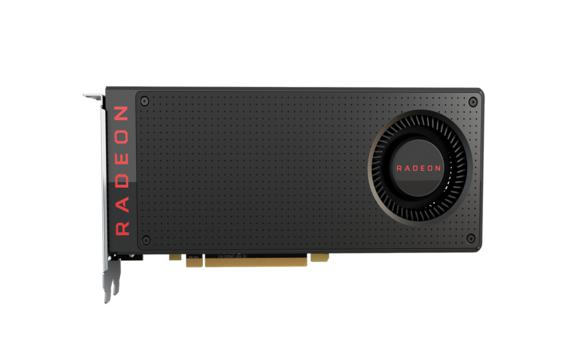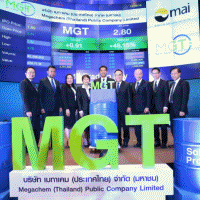- Details
- Category: ไอที-เทคโนฯ
- Published: Tuesday, 07 June 2016 23:10
- Hits: 5404

AMD ส่ง Radeon? RX 480 ตั้งเป้าส่งมอบประสบการณ์ด้าน VR ให้กับผู้ใช้งานนับล้านในราคาเริ่มต้นเพียง $199
กราฟฟิกการ์ดสถาปัตยกรรม Polaris รุ่นแรกที่จะสร้างประสบการณ์ด้าน VR ระดับพรีเมี่ยม ที่ใช้พลังงานน้อยลงครึ่งหนึ่ง คาดจะเพิ่มความต้องการใช้งานด้าน VR และเร่งการเติบโตของกลุ่มผู้ใช้งาน VR
COMPUTEX 2016 ไทเป, ไต้หวัน - AMD (NASDAQ: AMD) เผยกลยุทธ์สำหรับกราฟฟิกการ์ด Radeon? RX Series สถาปัตยกรรม Polaris architecture พร้อมเปิดตัว VR ที่มีประสิทธิภาพอันน่าประทับใจและเทคโนโลยีใหม่ๆ โดยจะวางจำหน่ายในราคาที่หลากหลาย ทั้ง Radeon RX 480 มีความสามารถด้าน VR อันยอดเยี่ยมในราคาเริ่มต้นเพียง $199 สำหรับรุ่น 4GB ทาง AMD มีแผนที่จะจำหน่ายในวันที่ 29 มิถุนายนนี้ Radeon? RX 480 จะเป็นโซลูชั่นสำหรับพีซี สำหรับ VR โดยจะมาพร้อมกับราคาที่ถูกลง แต่มีความสามารถด้าน VR เทียบเท่ากับกราฟฟิกการ์ดราคา $500
“VR เป็นเทคโนโลยีด้านการประมวลผลแบบ immersive ที่เป็นที่รอคอยมากที่สุด และเป็นการตอกย้ำการ คาดการณ์ตั้งแต่ปี 2008 ของ AMD’s Cinema 2.0 vision ถึงการผสานกันของประสบการณ์ immersive และ interactivity” Raja Koduri รองประธานกรรมการอาวุโสและผู้อำนวยการด้านสถาปัตยกรรมแห่ง Radeon Technologies Group ของ AMD กล่าว “ขณะที่เราพยายามนำเทคโนโลยี VR มาใช้ในชีวิตประจำวันมากขึ้น ต้นทุนยังคงเป็นประเด็นหลักที่ทำให้เราสามารถเลือกพัฒนาเทคโลโลยี VR ให้กับผลิตภัณฑ์บางประเภทเท่านั้น Radeon? RX Series จะเป็นเทคโนโลยีที่จะเข้ามาพลิกโฉมวงการ โดยจะเปลี่ยนให้ VR เป็นเทคโนโลยีที่ตอบโจทย์ผู้ใช้งานมากขึ้น”
จากผลการสำรวจชิ้นสำคัญ ราคาเป็นปัจจัยสำคัญที่ผู้ใช้งานใช้ในการตัดสินใจเลือก ทั้งนี้เทคโนโลยี VR ในราคาเริ่มต้นที่ $199 สำหรับกราฟฟิกการ์ด Radeon RX Series บางรุ่น จะเป็นตัวเปิดทางให้ผู้คนหันมาใช้ VR มากยิ่งขึ้น และเป็นการผลักดันการเติบโตของ ผู้ใช้งาน VR AMD คาดว่าราคาที่เปิดตัวใหม่นี้จะช่วยสร้างความต้องการพีซี สำหรับ VR และจะทำให้ให้ราคา headset สำหรับ VR ลดลง
เดสก์ท็อป และโน้ตบุ๊กที่พร้อมใช้งาน VR ในราคาที่สามารถเอื้อมถึง: AMD คาดว่าพีซีสำหรับ VR โดยกราฟฟิกการ์ดสถาปัตยกรรม Polaris จะเข้าถึงผู้ใช้งานกว่า 100 ล้านคนภายใน 10 ปีข้างหน้า ช่วยให้ VR เข้าถึงลูกค้ารายย่อยได้: ขณะนี้การจำหน่ายเทคโนโลยี VR ผ่านช่องทางรีเทลยังคงเป็นเรื่องยาก เพราะมีราคาสูงกว่า $999 ทั้งนี้กราฟฟิกการ์ด Radeon? RX Series จะให้ OEM สามารถผลิตเดสก์ท็อปและโน้ตบุ๊กที่สามารถใช้งาน VR ได้ในราคาที่สามารถเอื้อมถึง เหมาะสำหรับตลาดรีเทลพีซี ให้นักพัฒนา VR เข้าถึงผู้ใช้งานได้มากขึ้น: การที่ผู้ใช้งานทั่วไปหันมาใช้เทคโนโลยี VR จะเป็นแรงกระตุ้นให้นักพัฒนาหันมาสร้างแอพพลิเคชั่นสำหรับ VR ที่หลากหลายมากขึ้น ไม่ว่าจะเป็นด้านการศึกษา บันเทิง และการทำงาน โดยทางนักพัฒนาต่างหาหนทางที่จะใช้ประโยชน์จากความนิยมที่เพิ่มมากขึ้นเรื่อยๆ ของ VR ลดค่าใช้จ่ายสำหรับผู้ที่เริ่มใช้ VR: AMD คาดว่าพีซีสำหรับ VR ในราคาที่ถูกลงจะช่วยให้ผู้ใช้งานหันมาใช้ VR มากขึ้น อีกทั้งยังเป็นการกระตุ้นความสนใจของนักพัฒนาและเพิ่มการผลิต HMD ซึ่งจะส่งผลให้ค่าใช้จ่ายลดลงสำหรับการใช้งาน VR ในระยะแรกเพราะในท้ายที่สุดแล้วราคาผลิตภัณฑ์ทั้งระบบของ VR จะลดลง
“ประสิทธิภาพของ Radeon? RX series เป็นผลมาจากการปรับปรุงด้านสถาปัตยกรรมและเทคโนโลยี14nm FinFET สำหรับ GPU แบบ discrete จะเป็นจุดเปลี่ยนสำคัญสำหรับความก้าวหน้าของเทคโนโลยี VR” Patrick Moorhead นักวิเคราะห์ของ Moor Insights&Strategy กล่าว “Radeon? RX series จะช่วยผลักดันให้ระบบ VR พร้อมสำหรับจำหน่ายในตลาดรีเทลในปริมาณที่สูงขึ้น และจะช่วยให้เกิดการลงทุนพัฒนาคอนเทนต์สำหรับ VR ที่เพิ่มขึ้น ทั้งยังเป็นการลดต้นทุนของ headsets สำหรับ VR อีกด้วย”
“เรารู้สึกยินดีเป็นอย่างยิ่งที่ AMD ได้มอบกราฟฟิกการ์ดสำหรับ VR ให้ผู้ใช้งานทั่วไปในราคาเริ่มต้นที่ $199” Dan O’Brien รองประธานกรรมการด้านเทคโนโลยีเสมือนจริงของ HTC กล่าว “สิ่งนี้แสดงให้เห็นถึงความมุ่งมั่นของ AMD ในการศึกษาระบบทั้งหมดของ VR เพื่อสร้างสรรค์นวัตกรรมอย่าง Radeon RX Series เพื่อให้เป็นขุมพลังระบบ VR ระดับ high end อย่าง HTC Vive และยังเข้าถึงผู้ใช้งานทั่วไปได้มากขึ้นอีกด้วย”
“เราได้สัมผัสกับแอพพลิเคชั่นแบบ immersive และประสบการณ์ที่ให้กับผู้คนนับล้านทั่วโลกสัมผัสกับเทคโนโลยีเสมือนจริง” Nate Mitchell รองประธานกรรมการด้านผลิตภัณฑ์แห่ง Oculus กล่าว “AMD จะช่วยผลักดันการใช้ VR อีกขั้นหนึ่ง ด้วยกราฟฟิกการ์ดสำหรับ VR ที่จำหน่ายในราคา $199”
การเปิดตัว Radeon? RX Series ถือจุดเริ่มต้นของกลยุทธ์ Water Drop ซึ่งตั้งเป้าที่จะปล่อยกราฟฟิกการ์ดตัวใหม่เพื่อเพิ่มยอดขายให้กับกราฟฟิกการ์ด Radeon? ในเดือนพฤษภาคม ปี 2016 Mercury Research ได้รายงานว่ากราฟฟิกการ์ดแบบ discrete ของ AMD มีส่วนแบ่งการตลาด 3.2% ในไตรมาสที่ 1 Radeon? RX Series จะมาเพิ่มโอกาสให้กับพีซีเกมมิ่ง ทั้งนี้ มีพีซีเกมเมอร์กว่า 13.8 ล้านรายที่ใช้เงินราว $100-300 ในการอัพเกรดกราฟฟิกการ์ด 84% ของการแข่งขัน และการเล่นเกมส์บนเดสก์ท็อปด้วยกราฟฟิกการ์ด Radeon? RX Series สถาปัตยกรรม Polaris ที่มาพร้อมกับประสิทธิภาพการทำงานที่สูงขึ้น จะช่วยส่งมอบประสบการณ์ด้าน VR อันน่าตื่นตาตื่นใจ และฟีเจอร์ที่หลากหลายในราคาที่ไม่เคยมีใครจำหน่ายมาก่อน
ท่านสามารถศึกษาข้อมูลเพิ่มเติมเกี่ยวกับกราฟฟิกการ์ด Radeon? RX Series สถาปัตยกรรม Polaris ที่จะวางจำหน่ายในเดือนนี้ได้ที่ AMD Newsroom และโซเชียลมีเดียที่เกี่ยวข้อง
เกี่ยวกับ AMD: เป็นเวลากว่า 45 ปีที่ AMD สร้างสรรค์นวัตกรรมการประมวลผลประสิทธิภาพสูง กราฟฟิก และเทคโนโลยีการแสดงผล ซึ่งเป็นส่วนสำคัญสำหรับเกมมิ่ง immersive platform และศูนย์ข้อมูล (data center) ลูกค้ากว่าร้อยล้านคนของเรา รวมถึงบริษัทชั้นนำที่ถูกจัดอันดับให้อยู่ใน Fortune 500 และหน่วยงานวิจัยทางวิทยาศาสตร์ ต่างใช้เทคโนโลยีของ AMD ในการเพิ่มความสะดวกสบายในชีวิตประจำวัน รวมถึงนำมาช่วยในการทำงานให้ดียิ่งขึ้น และเพิ่มความเพลิดเพลินสำหรับการพักผ่อนหย่อนใจ พนักงานของเราทั่วโลกต่างมุ่งมั่นในการพัฒนาผลิตภัณฑ์ที่จะทำให้สามารถก้าวข้ามข้อจำกัดเดิมๆ ท่านสามารถเยี่ยมชม website, blog, Facebook และ Twitter เพื่อศึกษาเรื่องราวเพิ่มเติมของเราในการทำให้ปัจจุบันเป็นจริงในขณะที่เราจุดประกายอนาคตอย่างต่อเนื่อง
-------------------------------
Radeon? RX 480 set to drive premium VR experiences into the hands of millions of consumers; starting at just $199
First Polaris architecture-based graphics processor to deliver premium VR capability with less than half the power consumption; expected to accelerate the size of the VR-ready install-base and dramatically increase the pace of VR ecosystem growth
COMPUTEX 2016, TAIPEI, Taiwan AMD (NASDAQ: AMD) today unveiled the company’s strategy for its upcoming Polaris architecture-based Radeon? RX Series graphics cards, introducing impressive levels of VR performance and future-proof technologies at a variety of price points. The Radeon RX 480 delivers premium VR capability at a stunning price of starting at just $199 for the 4GB edition.
Set for launch and availability on June 29th, the Radeon? RX 480 will deliver the world’s most affordable solution for premium PC VR experiences, delivering VR capability common in $500 GPUs.
“VR is the most eagerly anticipated development in immersive computing ever, and is the realization of AMD’s Cinema 2.0 vision that predicted the convergence of immersive experiences and interactivity back in 2008,” said Raja Koduri, senior vice president and chief architect, Radeon Technologies Group, AMD. “As we look to fully connect and immerse humanity through VR, cost remains the daylight between VR being only for the select few, and universal access for everyone. The Radeon? RX Series is a disruptive technology that adds rocket fuel to the VR inflection point, turning it into a technology with transformational relevance to consumers.”
In a notable market survey, price was a leading barrier to adoption of VR. The $199 starting SEP for select Radeon RX Series GPUs is an integral part of AMD’s strategy to dramatically accelerate VR adoption and unleash the VR software ecosystem. AMD expects that its aggressive pricing will jumpstart the growth of the PC VR TAM and accelerate the rate at which VR headsets drop in price:
More affordable VR-ready desktops and notebooks: AMD expects that affordable PC VR enabled by Polaris architecture-based graphics cards will drive a wide range of VR-ready desktops and notebooks, providing a catalyst for the expansion of the addressable market to an estimated 100 million consumers over the next 10 years.
Making VR accessible to consumers in retail: Thus far, retail has not been a viable channel for VR sales as average system costs exceeding $9993 have precluded VR-ready PCs from seeing substantial shelf space. The Radeon? RX Series graphics cards will enable OEMs to build ideally priced VR-ready desktops and notebooks well suited for the retail PC market.
Unleashing VR developers on a larger audience: Adoption of PC VR technologies by mainstream consumers is expected to spur further developer interest across the ecosystem, unleashing new VR applications in education, entertainment, and productivity as developers seek to capitalize on the growing popularity of the medium.
Reducing the cost of entry to VR: AMD expects that affordable PC VR enabled by Polaris architecture-based graphics cards will dramatically accelerate the pace of the VR ecosystem, driving greater consumer adoption, further developer interest, and increased production of HMDs, ultimately resulting in a lower cost of entry as prices throughout the VR ecosystem decrease over time.
“The Radeon? RX series efficiency is driven by major architectural improvements and the industry’s first 14nm FinFET process technology for discrete GPUs, and could mark an important inflection point in the growth of virtual reality,” said Patrick Moorhead, principal analyst, Moor Insights & Strategy. “By lowering the cost of ownership and increasing the VR TAM, Radeon RX Series has the potential to propel VR-ready systems into retail in higher volumes, drive new levels of VR content investment, and even drive down the cost of VR headsets.”
“We congratulate AMD for bringing a premium VR ready GPU to market at a $199 price point,” said Dan O’Brien, vice president of virtual reality, HTC. “This shows how partners like AMD survey the entire VR ecosystem to bring an innovative Radeon RX Series product to power high end VR systems like the HTC Vive, to the broadest range of consumers.”
“We’ve seen an incredible range of immersive applications and game-changing experiences that have given millions of people around the world their first taste of virtual reality,” said Nate Mitchell, VP of Product, Oculus. AMD is going to help drive that adoption forward even more by bringing their high-end VR GPUs to the $199 price point.”
The Radeon? RX Series launch represents the first salvo in AMD’s new “Water Drop” strategy aimed at releasing new graphics architectures in high volume segments first to support continued market share growth for Radeon? GPUs. In May 2016, Mercury Research reported that AMD gained 3.2% market share in discrete GPUs in Q1 2016. The Radeon? RX Series will address a substantial opportunity in PC gaming: more than 13.8 million PC gamers who spend $100-300 to upgrade their graphics cards, and 84% of competitive and AAA PC gamers. With Polaris architecture-based Radeon? RX Series graphics cards, AMD intends to redefine the gaming experience in its class, introducing dramatically improved performance and efficiency, support for compelling VR experiences, and incredible features never before possible at these prices.
For more information on Polaris architecture-based Radeon? RX Series graphics cards availability later this month, stay tuned to the AMD newsroom and associated social media channels.
About AMD : For more than 45 years AMD has driven innovation in high-performance computing, graphics, and visualization technologies ? the building blocks for gaming, immersive platforms, and the datacenter. Hundreds of millions of consumers, leading Fortune 500 businesses, and cutting-edge scientific research facilities around the world rely on AMD technology daily to improve how they live, work, and play. AMD employees around the world are focused on building great products that push the boundaries of what is possible. For more information about how AMD is enabling today and inspiring tomorrow, visit the AMD (NASDAQ: AMD) website, blog, Facebook and Twitter pages.







































































